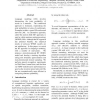Free Online Productivity Tools
i2Speak
i2Symbol
i2OCR
iTex2Img
iWeb2Print
iWeb2Shot
i2Type
iPdf2Split
iPdf2Merge
i2Bopomofo
i2Arabic
i2Style
i2Image
i2PDF
iLatex2Rtf
Sci2ools
ACL
2015
2015
Trans-dimensional Random Fields for Language Modeling
Language modeling (LM) involves determining the joint probability of words in a sentence. The conditional approach is dominant, representing the joint probability in terms of conditionals. Examples include n-gram LMs and neural network LMs. An alternative approach, called the random field (RF) approach, is used in whole-sentence maximum entropy (WSME) LMs. Although the RF approach has potential benefits, the empirical results of previous WSME models are not satisfactory. In this paper, we revisit the RF approach for language modeling, with a number of innovations. We propose a trans-dimensional RF (TDRF) model and develop a training algorithm using joint stochastic approximation and trans-dimensional mixture sampling. We perform speech recognition experiments on Wall Street Journal data, and find that our TDRF models lead to performances as good as the recurrent neural network LMs but are computationally more efficient in computing sentence probability.
| Added | 13 Apr 2016 |
| Updated | 13 Apr 2016 |
| Type | Journal |
| Year | 2015 |
| Where | ACL |
| Authors | Bin Wang, Zhijian Ou, Zhiqiang Tan |
Comments (0)

